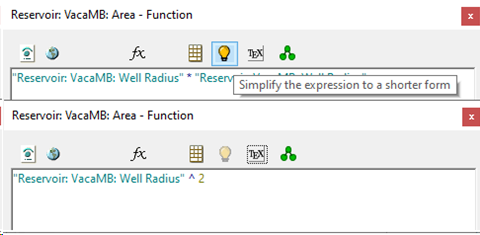PetroVR 2023 v2 Release Notes
PetroVR 2023 v2 introduces two new key Carbon Capture capabilities: the option to perform volumetric calculations for CO2 storages (typically aquifers), and the ability to route emissions to different destinations (injection facilities), accounting for differentiated transportation costs.
This version also expands the possibilities to share and analyze your simulation results: the CVS and JSON export options or databases.
And regarding speed and user experience, it implements multi-process parallel calculations for Sensitivity, and a brand-new Variable Navigation System (the Depedency Graph).
PetroVR 2023 v2 New Capabilities
Carbon Capture, Utilization, and Storage
CO2 Storage Volumetrics
The trapping capacity of CO2 Storages can now be calculated by considering factors such as Area, Thickness, Porosity, CO2 Density, and Efficiency. Furthermore, both CO2 Density and Efficiency can also be approximated using various techniques and physical/geological properties of the storage, that can also be used to better analyze uncertainties.

Multiple CO2 Emission Destinations and Transport
From this version on, you can create more than one CO2 Injection facility in the model, and route different emission sources to different destinations. In addition, you can model variable costs for each of these connections between emission sources and storages, accounting for specific transportation costs.
Data Analysis Tools
New CSV Simulation Output & Power BI Templates
With this new option, you can easily export the full set of PetroVR outputs to browse them in your favorite data visualization tool.
The export to the standard Comma Separated Values provides a direct mechanism to export ALL relevant information from a PetroVR run, including all scenario details and Monte Carlo data, to any data visualization tool, such as Power BI (a template to load these files is included with this PetroVR version). Since the data is already organized in a tabular format, mapping it is a straightforward, almost automatic process.

New Excel Reports
In addition, new Excel reports are available for scenarios: “All Scenarios – Incremental", “Well Production Rates” and “Well Production rates - Incremental” provide detailed production profiles of all active scenarios in a single report.
Integration with other Quorum Products
New Scenario to Dataflow Express Export
The Express Dataflow Export is now available for scenarios: export all active scenarios in a single operation with this new compact and user-friendly option.
Probabilistic Analysis tools and Speed
Multi-Core for Sensitivities
This version introduces multi-core processing for the three Sensitivity tools: Spider, Sensitivity on Variable Values, and Sensitivity on Variable Distributions. The new functionality enables you to take advantage of all processing cores available on the computer, allowing for dramatically speeding up the process of running these tools.

Quality & User Experience
Navigating Variables with Dependency Graphs
A new option to graphically navigate between variable dependencies, available from the function edition window, enables a powerful way to edit functions, in a faster and more user-friendly way.

The option opens a window a graph where the current variable, along with all the variables it references, are displayed: you can click on any of these variables to view their respective expressions and values, and even edit them.

New FML Simplification Options
Together with the Dependency graph, the edition of FML functions has been further enriched through the introduction of a new feature within the Expression Simplifier. This built-in tool helps you optimize your expressions by identifying and replacing segments that are redundant or can be expressed in a simpler manner. Notably, the simplifier now identifies expressions that can be rewritten as powers of a specified value.

Enhancements and Tests Included in this Version
Several minor enhancements have been implemented impacting calculation speed, modeling flexibility and user experience.
- 18 enhancements delivered as updates during 2022
- 429 new functional test cases
- 68 new unit tests
